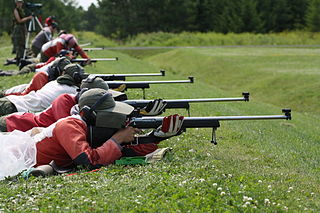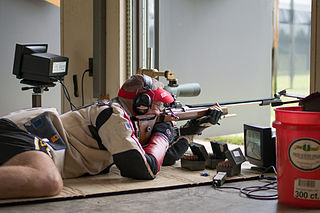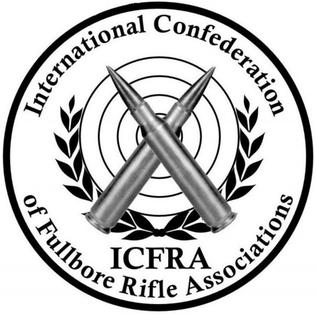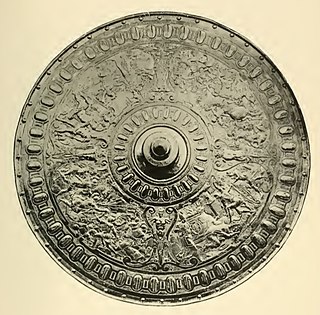
Shooting sports is a group of competitive and recreational sporting activities involving proficiency tests of accuracy, precision and speed in shooting — the art of using ranged weapons, mainly small arms and bows/crossbows.

In the United States (U.S.), a marksmanship badge is a U.S. military badge or a civilian badge which is awarded to personnel upon successful completion of a weapons qualification course or high achievement in an official marksmanship competition. The U.S. Army and the U.S. Marine Corps are the only military services that award marksmanship qualification badges. However, marksmanship medals and/or marksmanship ribbons are awarded by the U.S. Navy, U.S. Coast Guard, and U.S. Air Force for weapons qualifications. For non-military personnel, different U.S. law enforcement organizations and the National Rifle Association (NRA) award marksmanship qualification badges to those involved in law enforcement. Additionally, the Civilian Marksmanship Program (CMP) and the NRA award marksmanship qualification badges to U.S. civilians. Most of these organizations and the U.S. National Guard award marksmanship competition badges to the people they support who succeed in official competitions.
The New Zealand Service Rifle Association (NZSRA) is the national organising body for service rifle competition in New Zealand. NZSRA promotes service rifle shooting, sets rules for service rifle competition, holds annual national championships, and supports the ownership of service rifles.

Practical shooting, also known as dynamic shooting or action shooting, is a set of shooting sports in which the competitors try to unite the three principles of precision, power, and speed, by using a firearm of a certain minimum power factor to score as many points as possible during the shortest time. While scoring systems vary between organizations, each measures the time in which the course is completed, with penalties for inaccurate shooting. The courses are called "stages", and are shot individually by the shooters. Usually the shooter must move and shoot from several positions, fire under or over obstacles and in other unfamiliar positions. There are no standard exercises or set arrangement of the targets, and the courses are often designed so that the shooter must be inventive, and therefore the solutions of exercises sometimes vary between shooters.

Metallic silhouette shooting is a group of target shooting disciplines that involves shooting at steel targets representing game animals at varying distances, seeking to knock the metal target over. Metallic silhouette is shot with large bore rifles fired freehand without support out to 500 meters, and with large bore handguns from the prone position with only body support out to 200 meters. Competitions are also held with airguns and black-powder firearms. A related genre is shot with bow and arrow, the metal targets being replaced with cardboard or foam. The targets used are rams, turkeys, pigs, and chickens, which are cut to different scales and set at certain distances from the shooter depending on the specific discipline.

NRA Precision Pistol, formerly known as NRA Conventional Pistol, is a national bullseye shooting discipline organized in the United States by the National Rifle Association of America. Emphasis is on accuracy and precision, and participants shoot handguns at paper targets at fixed distances and time limits. Other organizations in the United States and Canada have established rules and keep records of similar disciplines, including the Civilian Marksmanship Program (CMP) in the United States.

The National Rifle Association (NRA) is the governing body for full bore rifle and pistol shooting sports in the United Kingdom. The Association was founded in 1859 with the founding aim of raising funds for an annual national rifle meeting to improve standards of marksmanship. Today the NRA continues this objective as well as organising civilian target shooting and selecting British teams to contest the ICFRA World Championships. The National Shooting Centre at Bisley is a wholly-owned subsidiary of the association.

Fullbore Target Rifle (TR) is a precision rifle shooting sport discipline governed by the International Confederation of Fullbore Rifle Associations (ICFRA). The sport evolved as a distinct British and Commonwealth of Nations discipline from Service rifle (SR) shooting in the late 1960s. Its development was heavily influenced by the British National Rifle Association (NRA). Due to this history, it is usually contested amongst the shooting events at the Commonwealth Games, although not at the Olympics. World Championships are held on a four-year cycle. The annual NRA Imperial Meeting at Bisley in the UK is globally recognised as a historic annual meeting for the discipline.

The ANZAC Rifle Range is a rifle range located on the Malabar Headland, Malabar, in the City of Randwick local government area of New South Wales, Australia. It is headquarters to the New South Wales Rifle Association, and hosts the annual NSW Queen's Prize shooting competitions. The range is located on land owned by the Commonwealth of Australia.
Gallery rifle shooting or gallery rifle and pistol shooting is a popular shooting sport throughout the world. In countries such as the UK, Ireland, Germany, South Africa and Australia national and international competitions are regularly undertaken. The discipline commonly uses rifles shot at short and medium distances chambered for traditional pistol calibers such as .22 Long Rifle, .38 and .357 calibers, .44 and .45. It is popular in countries where traditional pistol shooting is difficult or not possible. In the UK Long Barreled Pistols (LBPs) and Long Barreled Revolvers (LBRs) are also part of the overall discipline.

High Power Rifle, also called XTC from "Across the Course", is a shooting sport using fullbore target rifles which is arranged in the United States by the National Rifle Association of America (NRA). The sport is divided into classes by equipment, and popular types of matches include Service Rifle, Open, Axis and Allies and metallic silhouette. The term High Power Rifle sometimes also includes the international shooting disciplines of Palma and F-Class by the International Confederation of Fullbore Rifle Associations (ICFRA) which are represented by the NRA in the United States.
The Army Operational Shooting Competition (AOSC), is the British Army's premier shooting competition. Part of the Defence Operational Shooting Competition (DefOSC), it is based at the National Shooting Centre in Brookwood, Surrey. It also uses Ministry of Defence (MOD) ranges in the vicinity, such as Ash and Pirbright.

The National Shooting Centre is the UK's largest shooting sports complex, comprising several shooting ranges as well as the large "Bisley Camp" complex of accommodation, clubhouses and support services. The centre is located near the village of Bisley in Surrey from which it takes its colloquial name "Bisley ranges". The site is wholly owned by the National Rifle Association (NRA). The NSC is the trading name of the facility.

Bullseye shooting is a category of shooting sport disciplines where the objective is to score points with carefully placed precision fire by hitting a target as close to its center as possible. The name refers to the target center's nickname — the "bull's eye". In Scandinavia, this type of shooting competition is referred to as Range-Shooting, as it usually takes place at dedicated shooting range.

The International Confederation of Fullbore Rifle Associations (ICFRA) is the international association for the fullbore rifle shooting sports of Target Rifle ('TR') (in the US 'Palma' Rifle) and F-Class, which are long range competitions shot at distances between 300 and 900 meters or 300 to 1,000 yards depending on the range. F-Class shooters often shoot concurrently with the world's long-range TR shooters and use the same targets, except that the F-Class target has an extra ring half the diameter of the smallest in use for TR. ICFRA manages the programme of World Championships and other major matches for Fullbore Rifle and seeks to standardize the competition rules for TR and F-Class around the world. In competitions, wind reading skills are important. In order to hit their targets competitors must sense wind direction and speed and adjust their sights accordingly by applying knowledge and experience about wind's effect on the Trajectory of the bullet. World Long-Range Rifle Team and Individual Championships for both TR and F-Class are hosted every four years alternately two years apart. The winner of the World Long Range TR Team Championship is awarded the Palma trophy.

Shooting competitions for factory and service firearms refer to a set of shooting disciplines, usually called service rifle, service pistol, production, factory, or stock; where the types of permitted firearms are subject to type approval with few aftermarket modifications permitted. The terms often refer to the restrictions on permitted equipment and modifications rather than the type of match format. The names Service Rifle and Service Pistol stem from that the equipment permitted for these types of competitions traditionally were based on standard issue firearms used by one or several armed forces and civilian versions of these, while the terms production, factory and stock often are applied to more modern disciplines with similar restrictions on equipment classes.

South African Shooting Sport Confederation (SASSCo) formerly known as South African Shooting Sport Federation (SASSF) is the governing body for shooting sports in South Africa. SASSCo is the highest body responsible for the development and promotion of target shooting sports in South Africa. SASSCo is registered with both SASCOC and Sport and Recreation South Africa (SRSA) as the officially recognised overall federation for shooting sports in South Africa, and is also affiliated to the International Shooting Sport Federation (ISSF) and the African Shooting Sport Federation (ASSF).

Lieutenant-Colonel Richard Martyn Parsons was a British Army marksman who played an important role developing and testing small arms and ammunition during the Second World War, and whose performance in post-war rifle competitions established him as one of the finest rifle marksmen in Britain.

The Ashburton Shield is an historic trophy for rifle shooting in the United Kingdom and the British Isles. It is awarded annually to the winning team of VIII at the Schools Meeting, held at Bisley by the National Rifle Association. The competition is open to teams of cadets from, predominantly, Combined Cadet Force units based in public and private schools. A separate competition is held the week prior for cadet units not attached to a school, as part of the Inter-Services Cadet Rifle Meeting (ISCRM).
The Imperial Meeting is a major annual target shooting competition hosted by the National Rifle Association on the historic Bisley Camp in England.















